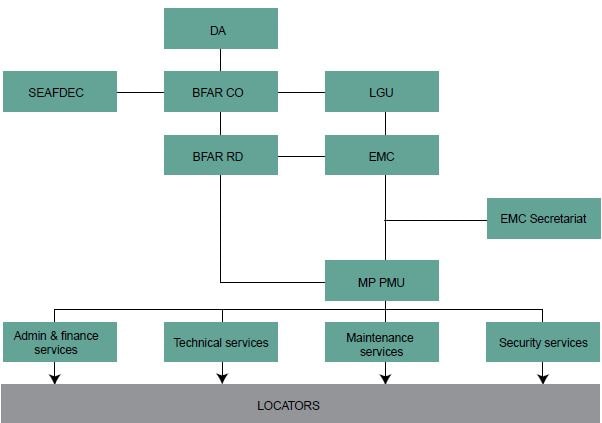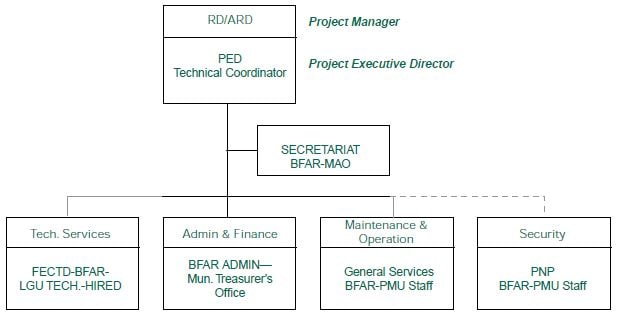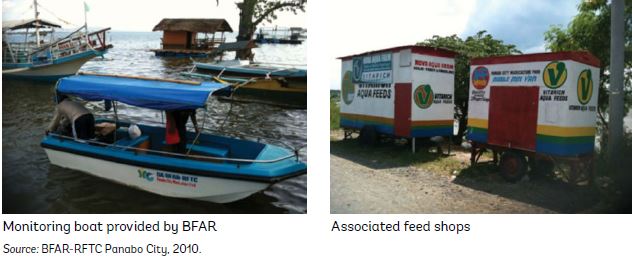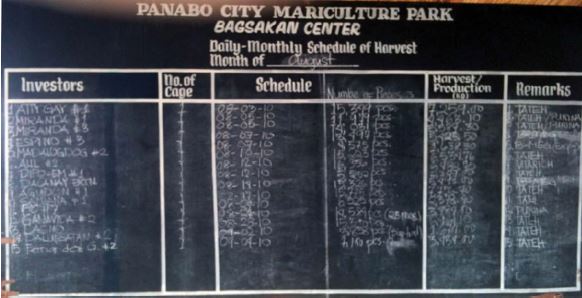5 Operation and Management
The operation of a mariculture park is basically a publicprivate sector partnership, and since a large percentage of the investments come from the private sector, its success is dependent on private sector investments and the efficient governance by the public sector.
The mariculture park is established with the fabrication of concrete blocks for permanent mooring systems ready for investors in designated areas based on the development plan. A two (2) hectares progressive technology demonstration area is allocated as a showcase to interested prospective locators and for training purposes.
Training is undertaken for mariculture investors:
• Caretakers Trainings
• Maintenance Crew Trainings
• Harvesters Trainings
• Livelihood Training (seaweeds, oysters, mussels, grouper)
• Trainings on CRM, environmental monitoring
• Entrepreneurial Trainings/business opportunities for fishers
• Training on Post-harvest/processing (value-added products development).
A one-stop shop is established for investors for fast approval of applications using standardized application forms for the issuance of lease/permits.
The organisational structure of the mariculture park and their functions are as follows:
• Department of Agriculture as the Executing Agency
• BFAR-Southeast Asian Fisheries Development Center (SEAFDEC)-LGU Signatories of the MOA
• EMC—Executive Management Committee takes charge for the over-all administration of the Marine Park Project
• BFAR-Regional Director (BFAR-RD) coordinates with the EMC on day-to-day operations
• BFAR-RD as Project Manager of Mariculture Park Management Unit (MPMU).
The management of the mariculture park is undertaken by an Executive Management Council, comprising of public, private and NGO members.
The Executive Management Council is chaired by the Local Government Executive or the Municipal Mayor and co-chaired by the BFAR Regional Director. It is composed of:
a. Municipal Agricultural Officer
b. SB Chairman—Committee on Agriculture
c. Barangay—Chairmen of Concerned Barangays
d. Representative from Department of Environment and Natural Resources Office (DENRO), e) Representative from Municipal Fisheries and Aquatic Resources Management Council (MFARMC)
e. BFAR Staff
f. Representative from the Locators Association (LA).
The Secretariat is from BFAR or LGU.
The responsibilities of the EMC are to provide the General Direction, set appropriate policies and standard operating
Figure 7. Organisational structure and functions for a mariculture park.

procedure, assumes the general functions of planning, directing/implementing, evaluation and monitoring and approval of action for execution of the Mariculture Park Management Unit (MPMU). The Chairman presides over all meetings, signs approval of resolutions, all official communications of the EMC, approved plans, budget and other permits associated with the conduction of mariculture and other ancillary industries of the mariculture park and approves disbursements of funds generated from the operation of the mariculture zone.
The Mariculture Park Management Unit (MPMU) implements the day-to-day operations of the MP ideally composed of the technical, maintenance, security and administrative services personnel. An MP Operations Manual containing all critical policies and regulations consistent to the principles of Good Aquaculture Practices (GAqP) standards is the main document that serves as the guide for all activities within the parks.
BFAR plays a major role in the management of MPs under a comanagement scheme with the LGUs as stipulated in the standard Municipal Ordinance and Memorandum of Agreement where, specifically BFAR shall provide for the technical assistance and financial support in the development of the MP.
BFAR Director/Regional Director is the cochairman of the EMC, which is the governing council of the MP and the Project Management Unite which implements the daily operational activities of the MP, it is composed of the BFAR-LGU staff, assigned or detailed to the Project Management Unit.
The initial cost of the development is shouldered by BFAR with cost sharing from the LGUs such as, technical study of the MP site, orientations and consultation activities, provision for demarcation of boundaries, (based on resource assessment conducted, TROPOMOD applications and EIA requirements), provision of the one (1) hectare mooring systems, launching expenditures, provision for two (2) units with at least three (3) clusters of cages as demonstration facilities including inputs, preparation in the application for ECC, conduction of
Figure 8. Suggested organisational structure of the Project Management Unit.

investment forum and production of IEC materials.
Demonstration cages are maintained by BFAR for new investors and to encourage other locators outside the locality to invest. Demonstration facilities (demo-cages have no specified time period to serve as show-case/ show-window to prospective investors/locators as they come. The same facilities are also used for practical hands-on training for new investors.
BFAR provide sustained assistance in the establishment of one-stop shopping to serve the investors, provide assistance in planning, project implementation, training for the necessary skills of caretakers and other maintenance staff, assists post-harvest activities, and assists investors access to financing and marketing of the product.
BFAR also in the early stage provides for a multipurpose motorboat, mobile technical and security staff, provides for a floating office which serves as the BFAR-LGU research and development headquarters and makes available the Regional Fish Health Laboratory to support the MPs.
Figure 9. Support from BFAR and local feed suppliers.
Figure 10. Communal facilities for fish landing and marketing.

BFAR in coordination with the Municipal Agriculture Office (MAO), provides extension services such as technical assistance and technical training and is channelled through the municipal LGU. It is the duty of the duly formed municipal Bantay Dagat Task force (seawatch) in coordination with the MAO and the municipal-based PNP to do the regular fisheries law enforcement activities.
The mariculture park provides communal facilities for all members including landing jetty, fish marketing area, and ice supply.
The stocking of fry and harvesting of fish is coordinated so that there is a continuous supply of fish to the market. Batches of harvested produce are labelled as to source, date of harvest, and other details following the GAqP guidelines for traceability requirements.
Figure 11. Coordination of the harvesting of fish from the different mariculture park producers and feed traceability.

Source: BFAR-RFTC Panabo City, 2010.